Superman Movies Ranked: The Best and Worst of the Man of Steel
How are all the Superman movies ranked? It was a challenge to get this one right.
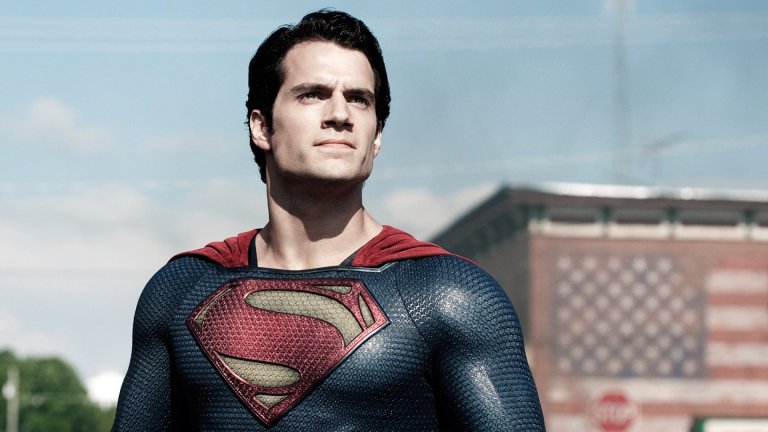
The Superman movie franchise is a tricky affair. While we’ve come to accept a certain comfortable sameness from our 21st Century superhero franchises, Superman’s big screen adventures since 1978 have, at various times, encompassed the very best and the very worst the genre has to offer, in ways you simply don’t see for other superheroes. For example, while Batman and Robin is nobody’s favorite Batman movie, it’s still a more competent production than Superman IV: The Quest for Peace. As a result, it may not be much of a surprise which Superman movies occupy the lower portions of this list, and which (mostly) live in the higher ones.
A quick disclaimer: I’ve omitted (but not forgotten) both of the Man of Steel’s movie serials, Superman (1948) and Atom Man vs. Superman (1951), simply because, despite playing in movie houses, they aren’t feature films, and the serial format played by a different, rather archaic, set of rules. I’ve also left out George Reeves’ debut as the Last Son of Krypton, Superman and the Mole Men (1951). While this one also played in theaters, its 60 minute runtime doesn’t qualify as a feature film, and it’s really a glorified pilot for the (excellent) Adventures of Superman TV series. I’m also not including the direct to home video animated Superman movies, such as the excellent Death of Superman and its sequel, Reign of the Supermen, as their roughly 70 minute runtime also don’t qualify them as feature films.
I tried hard not to let nostalgia cloud my judgement, and I’ve done my level best to spend as much time pointing out what works in these films as I do cataloguing their (many) weaknesses.
Now…up, up, and away!
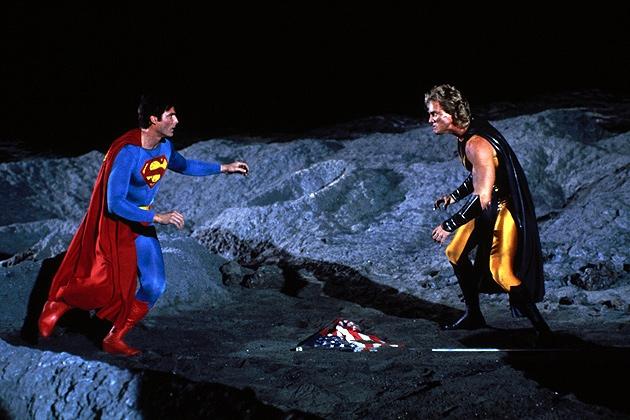
7. Superman IV: The Quest for Peace (1987)
Confession time. It pains me a little to write this entry. Given all that Christopher Reeve’s Superman portrayal has meant to me, trashing his final outing in the cape, not to mention an idealistic story that he personally felt strongly about, feels like I’m betraying my childhood a little bit. Superman IV: The Quest for Peace strives to deliver a message with its superheroics, one about the futility of the nuclear arms race of the 1980s.
Shouldn’t sincerity count for something, especially in a Superman movie?
Maybe, but while Superman IV’s heart is in the right place (and often on its sleeve), there’s simply no disguising what it is: a rushed, lazily-made film, suitable only for hardcore Kryptonian completists. The good-intentioned peacenik intentions of Superman IV aside, there’s no disguising the deeply cynical business decisions that plagued its production, resulting in a slashed budget, sad production values, and a core cast who not only look too old for their roles, but often appear to be simply going through the motions.
The sins of Superman IV are well documented, so there’s little point in cataloguing them here. In short, a terribly simplistic story, told with cringe-inducing dialogue, on a budget that is only a fraction of what a Superman movie needs all produce the expected results. The crimes against science (Mariel Hemingway’s younger/sexier romantic interest character breathes in space), politics (not one member of the UN questions Superman’s sudden need to rid the world of nuclear weapons), and common sense are numerous. Even in 1987, the special effects, particularly the flying sequences, are laughable affairs. And I don’t mean that they’re poor in comparison to the cinematic grace that audiences were treated to in Superman: The Movie, or poor in comparison to modern computer-aided sensibilities because, after all…they’re over 30 years old.
No, Superman IV quite simply looks like garbage.
Supes slugging it out with a superpowered foe (the obviously named “Nuclear Man”), with a color scheme that offsets Superman’s primaries seems like a great idea, right? After the strangely off-putting and mostly un-super Superman III (more on that in a minute), the return of Lex Luthor and the addition of someone of Nuclear Man’s power levels probably sounded like a slam dunk.
It should have been.
There are hints of the comic book Bizarro in Nuclear Man’s “imperfect duplicate of Superman” schtick (a deleted scene detailed a very Bizarro-esque Nuclear Man prototype), and there’s no shortage of action on display. Alexander Courage does a reasonable job with John Williams’ familiar motifs and adds his own nicely. Perhaps director Sidney J. Furie (Iron Eagle) could have done more with the film, and demanded more from his staff…but he would have needed a bigger budget and more time.
Setting aside Nuclear Man and the political message, there are some maddening glimpses into how Superman’s journey as a character from the first film could have been completed. Clark Kent dealing with the prospect of selling his parents’ farm is evocative and appropriately sentimental. His trip to the Fortress of Solitude (which is more colorful in this entry than previous films) to commune with Kryptonian elders about his right to interfere with human politics is a reasonable thematic progression from the issues he struggled with in the first installment. The scene where a rapidly aging Superman, dying of radiation poisoning, is forced to exhaust the last tie he has to Krypton in order to rejuvenate himself to defeat Nuclear Man is memorable, and in a better movie might have made for a fine sendoff for the entire franchise.
Instead, Superman IV is the only film on this list that I can honestly say that everyone involved, including the Man of Steel himself, would be better off without.
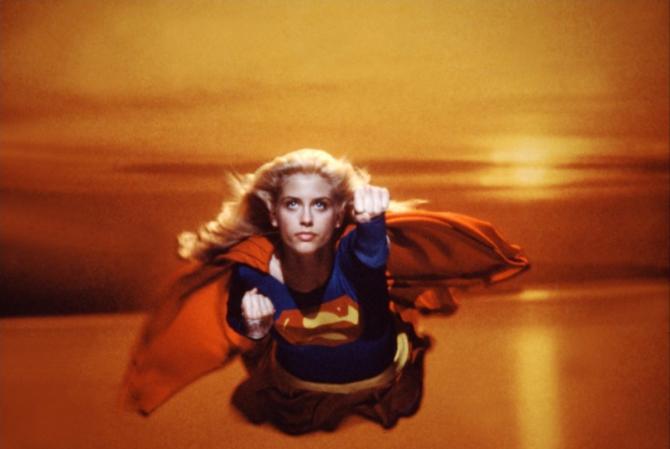
6. Supergirl (1984)
Supergirl really should be a much better movie. That’s a tune you’ll hear me whistle more than once as we continue on through this article. But it’s particularly distressing with this one. In 1984, audiences hadn’t had a proper live-action superheroine since Lynda Carter hung up her lasso in 1979. While Superman III wasn’t quite the heroic proposition fans had hoped for, the fresh start offered by his cousin would have been welcome.
It doesn’t succeed, but it has a handful of things going for it.
If nothing else this movie looks a hell of a lot better than Superman IV. It does more to increase the visual vocabulary of the Salkind Superman franchise than any of the other sequels. Supergirl’s home of Argo City is a more elaborate vision of Kryptonian society than the sparse, icy Krypton designed by John Barry for Superman: The Movie, but it helps establish that this movie is going for a lighter, more “magical” tone. We even get to journey into the Phantom Zone in this one, shown as a barren (but still physical) dimension. It’s not much, but considering how little actual Superman mythology was explored during the series’ run, I’ll take whatever I can get.
Most importantly, it boasts a lead who really deserved a shot at the character in a better film. But despite that impressive (and appropriately sincere) performance from Helen Slater as Kara/Supergirl, there’s little to save this from many of the same pitfalls that befell other superhero related films of this era. Supergirl gives us Faye Dunaway as Selena, a “wicked witch” in all but pointy hat and broom, who spouts dialogue like “What a pretty world, I can’t wait until it’s all mine.” She takes Peter Cook as her sniveling boyfriend/sidekick, Nigel.
If you thought Otis, Lex, and Miss Teschmacher weren’t much of a menace, wait until you meet the perpetually tipsy Nigel, Selena, and Bianca.
Right, so we’ve got Peter Cook, Faye Dunaway, and an excellent lead in Helen Slater. Marc McClure shows up for a turn as Jimmy Olsen (he’s dating Lois Lane’s sister, Lucy, who is Supergirl’s boarding school roommate). Now throw in Mia Farrow as Alura (Supergirl’s mother) and Peter O’Toole as Zaltar (Supergirl’s mentor) and this is one hell of a cast, isn’t it?
Yes, but they don’t make much of a difference.
BUT…(there’s always a “but” when I’m discussing Superman movies) there is one scene in this movie that is actually rather essential. Much of the Salkind produced Superman franchise adds up to what would be a really nice greatest hits package if you just pared away some of the more embarassing bits. In the case of Supergirl, Kara’s arrival on Earth is really something to behold. There’s some spectacular wire work on display as she discovers her powers, and the movie does everything in its power to make you believe a girl can fly.
Ultimately, not even Jerry Goldsmith’s heroic (if a tad overwrought) score can save this. Supergirl appears to have been written, not with young women in mind, but very young children. It has broad strokes of Superman mythology filtered through a 1980s fantasy movie lens (screenwriter David Odell wrote The Dark Crystal and followed Supergirl with Cannon’s Masters of the Universe). That wouldn’t be a bad thing, if only the final product weren’t so saccharine and unappealing. You are much better off with the TV show than this movie.
Oh, and your eyes do not deceive you. The hunky gardener that Selena and Supergirl compete for (yes, you read that right) is Hart Bochner. You know…Ellis from Die Hard.
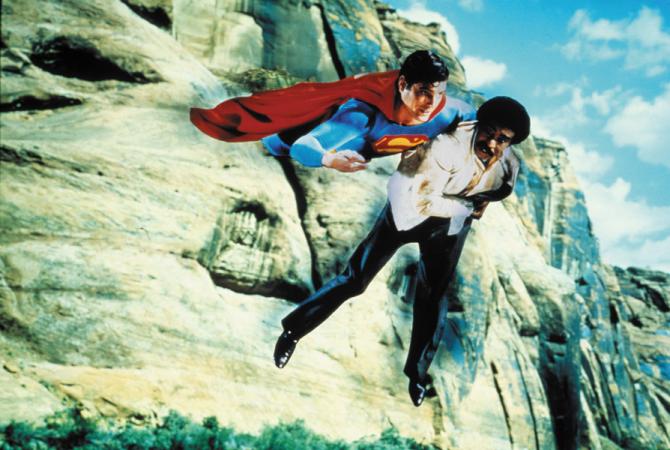
5. Superman III (1983)
While Superman IV: The Quest for Peace is probably even worse than you remember it, and Supergirl has generally been forgotten, Superman III is actually a better movie than its reputation suggests. The problem, of course, is that it isn’t really a Superman movie. That alone is enough to keep it in the bottom portion of this list. But it’s far more competently executed than the aforementioned entries, and it boasts a few scenes that are so remarkable that they would have been at home in (wait for it) a much better movie.
For one thing, Christopher Reeve never looked more convincing than he did in Superman III. He’s absolutely massive. The extra muscle and a few extra years (Reeve was only 24 during filming of Superman: The Movie) make a difference, and he’s actually more intimidating here than when he was kicking the hell out of Kryptonian fugitives in Superman II. Even when performing a seemingly mundane task like stopping a tractor from running over an irritating kid, Reeve looks like he could give other beefy action icons of the ’80s a run for their money in the alpha male department.
The wire work (despite the occasional visible wire) is spectacular, with Reeve’s takeoffs and landings standing out as particularly impressive. The chemical plant fire and rescue scene is an often overlooked part of Superman’s cinematic history, and it seems utterly convincing on a recent watch. For much of this, until the moment that Supes freezes a layer of a lake to drop on the raging fire (a trick that could have come right out of any of his Bronze Age comic book adventures), it’s all in-camera stuff, consisting of a blazing set with a flesh-and-blood Superman flying around it on wires. I had forgotten just how good this scene looked, and it’s one of the best uses of Superman I’ve ever seen in live-action. Even if you’ve written this movie off completely, consider giving this scene another look.
The junkyard fight sequence, which features a Superman corrupted by synthetic Kryptonite at war with himself makes for some triumphant cinema, and gave Reeve a chance to stray from his nice guy persona. The unfortunate turn of events that gets us here (Richard Pryor invents inferior synthetic Kryptonite that causes Superman to behave like a dick) is not worth giving too much thought to, but whatever. In particular, check out the shot where Clark is getting mauled in a trash compactor, it’s really great, surprisingly scary stuff.
The final battle with Gus Gorman’s supercomputer is another visual treat. Stripped of context, this is Christopher Reeve’s Superman doing battle with a version of Brainiac in all but name. There are two genuinely scary bits in here, too. The computer encases Superman in a techno-organic bubble that prevents him from breathing, which makes for a perfect sci-fi superhero visual. The computer then takes one of the villains as its unwilling robot slave, in a moment that sparked plenty of nightmares for impressionable kids in 1983. When director Richard Lester put his mind to it, he delivered some terrific Superman moments.
Hell, I’ll even give it up for the extended slapstick opening. If Superman III were, for example, a movie where he’s dealing with the Looney Tunes-esque villainy of someone like Mr. Mxyzptlk (yes, I typed that on the first try…pity me), then this would be hailed as genius. It’s not, though.
Future Smallville mom Annette O’Toole makes for a wonderful Lana Lang. Somewhere deep in Superman III‘s DNA is a proper third entry in this franchise, with Clark returning to Smallville, reconnecting with his first crush, reaffirming his heroism, and fighting Brainiac. None of these would involve Richard Pryor or Robert Vaughn.
I can heartily recommend a solid fifteen minutes of assorted Superman III scenes, which is considerably better than we’ve done so far for the films I ranked lower. We’re making progress. None of this changes the fact that the one hundred or so minutes that surround the above scenes are virtually torture. The argument can be made that Superman III is a Richard Pryor movie that just happens to feature Superman.
If that’s the case, it would still be a pretty lousy, unfunny Richard Pryor movie.
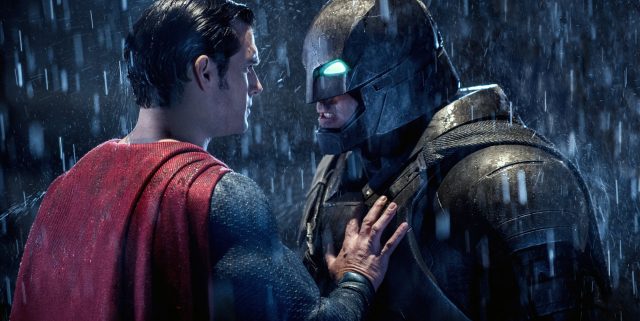
Batman v Superman: Dawn of Justice (2016)
I struggled with including this one. Batman v Superman: Dawn of Justice is a Superman movie only in the strictly technical sense. It features Superman, even though he’s reduced to second billing and often feels like a supporting player in his own film. Nevertheless, this is a direct and thematic sequel to 2013’s (much better) Man of Steel, so it ultimately makes the cut.
It’s a dubious honor, though. Batman v Superman is a brutal, miserable, overlong movie, and one that treats both of its title characters with utter contempt. But Superman mythology is particularly put through the wringer in this one. If you (like me) were enthralled by the care and worldbuilding that went into Superman’s alien origins and the smart, modern take on Lois Lane in Man of Steel, then this movie’s depiction of Superman as a dense mope, and its introduction of Lex Luthor as an ineffectual ham should be particularly galling.
While Batman and Superman are known to have their problems with each other’s methods in the comics, here they are equally unheroic and not terribly bright. Batman resorts to torture and, if not outright murder, certainly by accessory or neglect. Superman is a moody, scowling mess of uncertainty, who sacrifices himself in a moment that feels less selfless and more “I’ll show them for never appreciating me.”
Adding to the problems, Batman v Superman is unappealing visually. The climactic battles between Superman and Batman are indistinguishable video game cutscenes, and the final fight involving Superman, Batman, Wonder Woman, and Doomsday looks unfinished and muddy. Worst of all, the movie squanders one of the most important stories in all of Superman lore, cramming the Man of Steel’s death at the hands of Doomsday in as an afterthought, long before audiences have ever been given any reason to particularly like or sympathize with this version of the character.
Intended to help rush DC’s cinematic universe into being so that a Justice League movie could happen quicker, Batman v Superman is a cynical, focus-grouped affair, and its legacy is so profoundly damaging that it caused Justice League, released 20 months later after a troubled production, to fall flat at the box office. Warner Bros. did seem to learn its lesson from the reaction to this one, and by the time Justice League rolled around, Superman (and, for that matter, Batman) behaved far more like characters with consciences and less like video game avatars. (Note that Justice League isn’t ranked on this list, as it isn’t a Superman movie, merely one that the Man of Steel appears in for all of 15 minutes…but rest assured, it’s better than BvS, and not quite as bad as its reputation suggests).
It’s a shame that Henry Cavill, an inspired piece of superhero casting, was saddled with this by his second outing. And it’s not all bad. The scenes dealing with the immediate aftermath of the end of Man of Steel, and Superman’s effect on the world are certainly interesting. The longer “Ultimate Edition” director’s cut restores scenes and dialogue that help make both Superman and Batman’s motives considerably clearer, and it does help the film a little. It’s just all delivered with the subtlety of a Kryptonian haymaker.
Batman v Superman‘s overcooked, super-serious sturm-und-drang does at least make it funnier than Superman III…the problem is that it wasn’t intended to be.
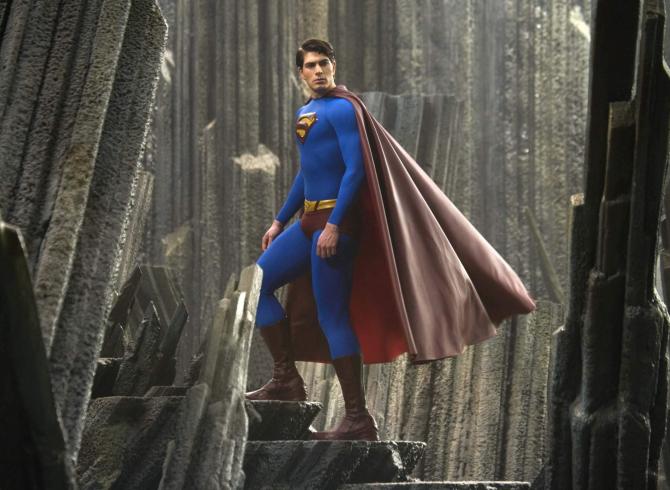
4. Superman Returns (2006)
In many ways, Batman v Superman, Superman Returns,and Superman III are equally flawed. It could be argued that Superman III or even BvS could be considered the superior film since it at least tried to do something remarkably different with the Superman formula. That doesn’t change the fact that, of the three, only Superman Returns is actually a Superman movie. The problem is that while Superman Returns may be a Superman movie, it’s actually a Superman movie that already got made.
Superman Returns would probably rank higher were it not so beholden to the story beats of another film on this list. Solid direction from Bryan Singer, and an impressive cast (Brandon Routh really deserved more than to end up as Superman’s George Lazenby) mask a script that appears to have been written by people whose only familiarity with the Superman legend was what they saw in 1978’s Superman: The Movie.
The basic premise of Superman Returns is a sound one, though. Why spend audience time and studio money establishing Superman’s origins when they’re already so familiar to audiences? What’s more, why try to duplicate or surpass the version of the Superman legend most familiar to audiences in the first place, that of Richard Donner’s Superman: The Movie?
As a result Superman Returns is a “vague sequel” to the Salkind films, minus III and IV, and whether or not Superman II ever took place in this continuity was never explained in a satisfactory fashion (although the novelization by Marv Wolfman hinted that this Superman had yet to encounter General Zod). One could imagine that Superman’s child was conceived in that silver space bed we saw Lois and Clark snuggling in during Superman II. Then again, there were plenty of potential off-camera opportunities for those two to conceive.
Superman Returns’ rather meta approach to the reintroduction of Superman, giving the character an absence from his fictional world that mirrors that of his absence from movie theaters, is clever enough. The problem is that instead of spending half a movie on an origin story, Superman Returns still chooses to spend nearly all of that early running time in a Superman-free zone. It’s a little self-defeating, especially considering the kind of spectacle audiences were accustomed to thanks to the thriving X-Men and Spider-Man franchises.
Kevin Spacey’s Lex Luthor is a more subdued, menacing creature than Gene Hackman’s. Brandon Routh plays Superman with a haunted dignity we’ve not seen from other actors, even if his Clark was very much patterned on Christopher Reeve’s performance. Bryan Singer certainly treats Superman more reverentially than any director since Richard Donner…perhaps even moreso. John Ottman even delivers a rousing version of John Williams’ familiar Superman themes, crafting his own incidental music that feels right at home in “this” world.
Despite the overt homages to the Richard Donner film, it’s more ambitious than what fans had come to expect from the franchise. While the decision to give Superman and Lois Lane a child was certainly a contentious one with fans, there’s no denying that Superman Returns was attempting to do something that no Superman movie had even considered in 25 years: move his story forward.
Superman never throws a punch in this one (be careful what you wish for, as we learned with Man of Steel and Batman v Superman), but there appears to be a genuine belief in the power of the Superman myth on display in Superman Returns, something that mostly hadn’t been seen since 1978. The space plane rescue is still a thrilling example of Superman’s abilities being put to good use by modern special effects, and despite the lack of capital-A ACTION, it’s often a beautifully photographed movie. Perhaps a few nods to wider Superman mythology would have brought in the necessary repeat business to validate another installment.
This isn’t to say that in order for a superhero movie to succeed it needs to be full of the kind of sequel teasing and self-referentiality of a Marvel Studios production. But Superman Returns was released only a year removed from Batman Begins, a movie that played with vast portions of Batman’s fictional real estate. It’s quite possible that this one was just the right movie at the wrong time. Superman Returns feels like the send-off for a long running film series, not the start of a new one.
In a way, that’s exactly what it is.
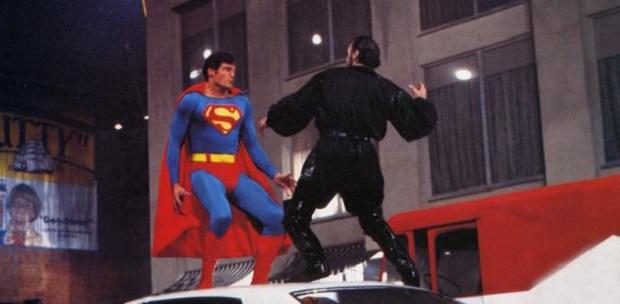
3. Superman II (1980)
To quote Valerie Perrine’s Eve Teschmacher in Superman: The Movie, “ummm…I know I’m gonna get rapped in the mouth for this,” but Superman II is not the best Superman movie. For years, Superman II held the reputation of being the definitive Superman film, likely by virtue of it (until recently, at least) having the most action. The sad fact remains that the behind-the-scenes drama that plagued virtually every Salkind production were fatally highlighted by the removal of Richard Donner after roughly half the movie had been shot and his replacement by Richard Lester.
Long before shared universes and the idea of splitting blockbuster movies in two became common practice in Hollywood, Superman and Superman II were the original five hour epic. In a perfect world, Superman II would have, no…should have been the ideal complement to the transcendent, good-hearted Superman: The Movie. After a movie where Supes spends his time rescuing people, getting kittens out of trees, and giving earnest answers to questions, having him deliver a solid ass-whupping to some leather clad creeps felt like a fine release.
And, to be sure, that’s exactly what Superman II is. But it’s also a dreadfully uneven film. It doesn’t take an obsessive to notice the seams are showing in this one, and the difference between Richard Donner’s earlier shot sequences and Richard Lester’s Salkind-mandated fill-ins and re-shoots are plain as day. Actors look different from scene to scene. Lex Luthor is only seen from behind or at a distance in a few crucial bits, since Gene Hackman refused to return for more shooting after Donner’s dismissal. The movie switches between lighter comedic moments and scenes of wholesale violence (the Phantom Zone criminals’ invasion of the White House is particularly heavy and effective) at will, and it can be a little jarring.
But even with all of those problems, Superman II still has plenty in its corner. There’s lots of energy held over from the first film, and, especially in the Donner-shot sequences, where the cast’s enthusiasm for the project is still on display. The final battle in Metropolis, while not as impressive to today’s eyes, is an absolute wonder of practical effects. Superman has yet to encounter anyone on screen with the sheer charisma of Terrence Stamp’s General Zod, made all the better by Sarah Douglas and Jack O’Halloran glowering menacingly over his shoulders.
“Oh God…” whimpers the President. “Zod,” the general calmly corrects him. They just don’t make ’em like ol’ Zod anymore.
The loss of Richard Donner’s singular vision for “verisimilitude” across both films caused a suitable outcry on the internet (once that became a thing) that Warner Bros. issued a re-edited version of the film, made up of reconstructed deleted scenes and assorted other odds and ends. Sadly Superman II: The Richard Donner Cut isn’t much of an improvement, despite the reinstatement of an all-important reunion with the spirit of Jor-El. While Lois Lane comes off looking like a particular idiot in Richard Lester’s version when she leaps into the rapids at Niagara Falls in order to coerce Clark Kent into revealing his secret identity, she fares little better in Donner’s, where she dives out a window at the Daily Planet for the same reason. The problems with Superman II, then, lay at a much deeper level than either director could have affected.
For one thing, Superman II had its original ridiculous ending, where Superman reverses the rotation of the earth in order to turn back time, poached for the first film. It was then forced to fall back on an equally ridiculous reset button at its conclusion. I’ll leave it up to you to decide which is harder to swallow, Superman turning back time by reversing Earth’s rotation, or Superman kissing Lois Lane with such potency that she forgets the events of the last few weeks. Either one would mar what is an otherwise satisfactory film, but considering the genuine romantic chemisty displayed by Reeve and Kidder in this one, it ends up feeling like a chunk of the movie was totally wasted. If Superman II actually had balls of steel, it would have ended with Lois Lane still holding full knowledge of Superman’s secret identity, stricken with the knowledge that their relationship could never progress, and knowing that to reveal his secret to the world would be the greatest evil of all.
Nevertheless, Superman II (with an assist from its predecessor) is handily the most ambitious Superman story ever attempted on screen. It goes far beyond the action. Superman relinquishing his birthright so he can love Lois, the ultimate reunion (with his father or his mother, depending on which version you watch) so those powers can return, the Shakespearean grudge that Zod holds against Kal-El…that’s a lot for one movie. It doesn’t quite hit the mark, but it isn’t for lack of trying.
Don’t blame Richard Lester, either. Even the Donner-directed portions lack the indescribable crackle and hum of the first film. As good as Superman II is, the shadow of how good it might have been will always hold it back.
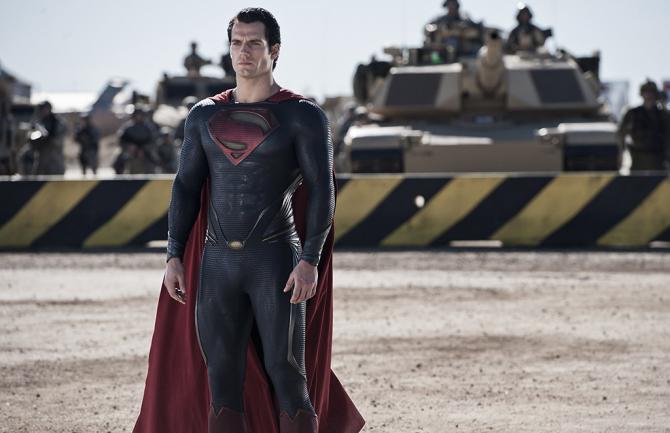
2. Man of Steel (2013)
Please put away your pitchforks and hear me out. Yes, it’s a fairly joyless affair, and in its desperate attempt to prove that it’s not its predecessor (the glacially paced and action-free Superman Returns) it sacrifices Superman’s optimistic heart on the altar of almost gleeful, consequence-free violence. Yes, it’s full of questionable decisions like a remarkably cynical and unlikeable Jonathan Kent (not Kevin Costner’s fault), the unnecessary “justifiable homicide” of General Zod, and that one scene when we’re supposed to believe that Henry Cavill is 17 years old.
But when you look at the things which sink other films on this list (a lack of broader Superman mythology, poor production values, lack of actual Superman, two vastly different directorial styles, being Batman v Superman), you’ll see none of them apply here. Don’t get me wrong, I don’t love this movie. I’m far more likely to reach for Superman II than Man of Steel, I’d imagine. Hell, I might even give the good fifteen minutes of Superman III another spin. But when looking at this 1) as a singular movie and 2) as a Superman movie, Man of Steel is handily one of the best entries in the character’s history.
In all categories that tend to define movies like this, Man of Steel comes out as a legitimate second best. It boasts the most impressive cast assembled for a Superman movie since the star-studded 1978 film. Hans Zimmer’s score may never be as iconic as John Williams’ instantly recognizable Superman theme, but it’s a rumbling, triumphant listen in its own right…and it’s the only one on here not tugging on Mr. Williams’ cape. It introduces and follows through on more elements of Superman mythology than any other film on this list, bar none. Henry Cavill is a perfectly believable Kryptonian, and we’ll hopefully get to spend more time with him in costume than anyone since Christopher Reeve before he’s done. Amy Adams delivers the first big-screen Lois smart enough to put two and two together, too, so that’s a nice change of pace.
So, while Man of Steel may not be the most loveable movie, it is, without question, the same movie at its beginning that it is at its end. I’m not sure you can say that about Superman II. The murder of General Zod is plainly a lazy way out of a tough situation, and it certainly annoys the purists (guilty), but is it any lazier than III’s synthetic Kryptonite antics or II‘s memory kiss? The lead creative team of Zack Snyder and David Goyer are plenty polarizing, but they did manage to take the reins and (a few hiccups aside) bring the wildly disparate and notoriously difficult elements of Superman’s cinematic vocabulary into line.
And in its own way, Man of Steel is quite a reverential film. There are nods to Superman: The Movie (the “S” as “a symbol of hope” is lifted not only from the Donner film’s idea of the “S” as a Kryptonian crest, but that film’s opening narration about “a symbol of hope for the city of Metropolis”), The Adventures of Superman TV series (it’s been awhile since we’ve had a ginger Lois, and Cavill’s slicked back Superman style is reminiscent of George Reeves), and the deeper parts of Superman lore (the shattered moon visible in the Kryptonian sky is Wegthor, accidentally destroyed by Zod’s flunky Jax-Ur).
And y’know what else? It’s a Superman movie without Lex Luthor, without the obligatory Kryptonite scene, and where Michael Shannon took on the mantle of Terrence Stamp’s iconic General Zod without feeling the need to pay homage at every turn. So, yes, Man of Steel is an often ugly, relentlessly bleak, and needlessly violent film. But it also encompasses more of the Superman legend and tells its own complete story in a way that none of the already discussed films managed to do.
The fact that Man of Steel occupies so high a spot on this list is less an endorsement of some kind of transcendent quality of its own, but rather a damning indication of just how poor most Superman movies are. So, while this one may be #2, make no mistake, it’s several light years away from…
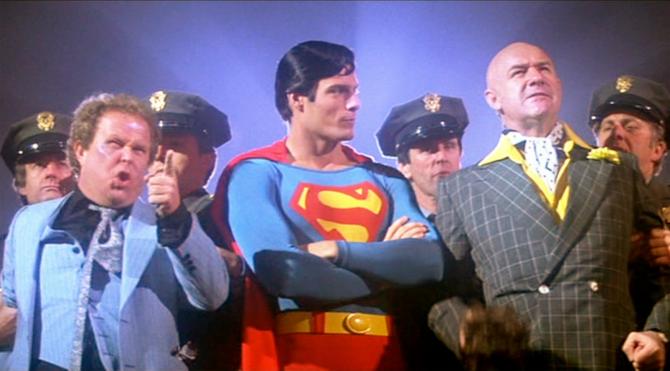
1. Superman: The Movie (1978)
Of course, if you’ve gotten this far, you know that none of the sequels, reboots, re-envisionings, or remakes ever approached the promise inherent in this movie. One glaring issue in the final act aside, I’m willing to stand Superman: The Movie up as not only the finest superhero movie ever made (and I will happily embrace the first movie to connect in such an emotional way that it knocks this one off its perch), but one of the finest genre films of its era. Visually, sonically, and cinematically, Superman: The Movie deserves to stand shoulder to shoulder with films like Star Wars and Raiders of the Lost Ark.
It’s only the increasingly inferior sequels that have obscured this over time.
The Superman legend was never treated with such reverence, nor was its mythic resonance ever so effortlessly captured. Superman: The Movie is at once very much of its time and yet still timeless. The Metropolis sequences, wide ties and instantly recognizable 1970s Manhattan cityscapes aside, would have been equally at home in the pre-war comic and radio stories that gave birth to the character, with frenetic dialogue that owes more than a little to the snappy patter of films like Bringing Up Baby or His Girl Friday.
Christopher Reeve’s casting remains the gold standard, not just for supermen, but superheroes in general. It’s usually only when an actor becomes almost indistinguishable from their superhero alter ego that the real magic happens (see also: Jackman, Hugh). And while Reeve would wear the cape in three more entries, and later expressed some trepidation about the role that brought him international stardom, it’s almost impossible to experience the sheer joy of the helicopter catch or the Air Force One rescue and not be utterly convinced that this guy may have had some Kryptonian DNA floating around in his gene pool. Surrounding the mostly unknown actor with a constellation of stars like Brando and Hackman (not to mention Margot Kidder who, for this brief moment, was a perfect romantic and comedic foil for Superman) only underline how both actor and character rose to the occasion.
Thanks to Richard Donner’s relentless commitment to “verisimilitude,” Superman: The Movie was the first superhero adaptation to actually surpass its source material (something that wouldn’t happen again for decades). Bringing in Star Wars production designer John Barry to turn Krypton from something that would have been at home in Flash Gordon serials into a truly alien, barren world was just one flourish. Making Superman the only brightly colored, powered character in a Metropolis that is an unmistakeably real New York City was another. John Williams delivering some of the most evocative music of his storied career didn’t hurt (I defy you to listen to “The Death of Jonathan Kent” and not feel something). And that cast…holy moley. All the anecdotes about Brando not giving a damn aside, that is one majestic presence as Jor-El.
Sure, you can make a case that the bit where Tom Mankiewicz and friends wrote themselves into a corner and Supes has to “turn back time” breaks the spell a little. So does Lois Lane’s embarassing spoken word poetry during an otherwise beautiful flying sequence. Maybe Lex Luthor could have done better than “surrounding himself with total nincompoops” like Otis and Miss Teschmacher. Or maybe we should really just relax, because the other two hours and twenty minutes are so magical that all can be forgiven.
The earliest marketing materials promised that “you’ll believe a man can fly” and you will. Vast chunks of the visual effects hold up quite well today, better than some of the weightless CGI from the last decade or so. A personal favorite will always be Supes’ takeoff after depositing Lois and an errant helicopter on the Daily Planet roof. If you’re feeling sentimental, you might still believe.
Superman: The Movie has cast such a long shadow over superhero movies that its protracted origin story format remains an almost inescapable component of the genre. Sam Raimi’s first Spider-Man deployed many elements of the STM formula of reverence for the source material and respect for the audience’s intelligence for its similarly note-perfect first half, and Batman Begins displays a similar pace. While the real promise of a high quality, long-running Superman franchise arriving at the dawn of the last great era of Hollywood science fiction and fantasy may never have been properly fulfilled, and Superman himself remains a notoriously tricky character to get right on the screen, the power, majesty, and soul on display in Superman: The Movie are “matters of undeniable fact.”
I sometimes envision an alternate universe where these films continued on after this one in some kind of logical direction, or even became a caped version of the Bond franchise, allowing new directors to showcase their vision for the last son of Krypton, with new actors donning the cape as necessary. No origin stories or reboots, just Superman facing off against a host of otherworldly menaces. Not all of these films would be great, of course, but I imagine all of them would have been better than Superman IV.
Now, if anybody wants to discuss where the Superman serials and Superman and the Mole Men would fit on a list like this had they been allowed, be my guest. Just make sure you put Superman and the Mole Men at #2.
